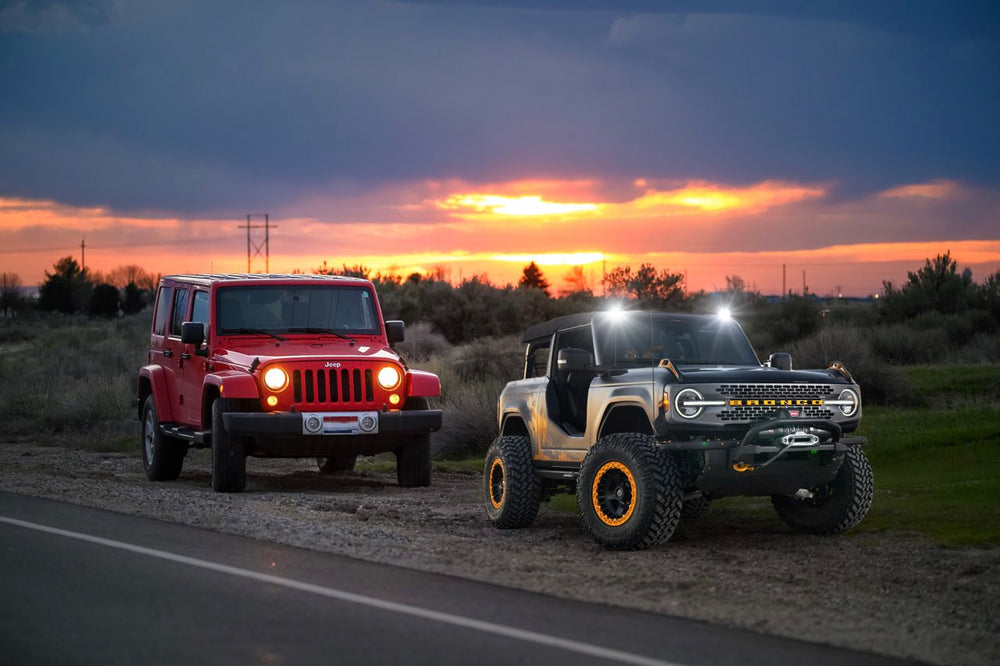Jeep Wrangler vs Ford Bronco

The off-road SUV space has been dominated by the Jeep Wrangler for many years, offering high levels of capability with an array of features such as four-wheel drive, locking differentials, and disconnecting sway bars, among other things.
However, the Ford Bronco has recently been reintroduced to the market after a lengthy absence and is poised to challenge the Wrangler's supremacy. The new Ford Bronco is designed to compete for head-on with the Wrangler, with similar off-road equipment such as a forward-facing camera, a disconnecting stabilizer bar, and knobby off-road tires.
In this article, we will explore the key features of the Jeep Wrangler and Ford Bronco, including their off-road and on-road capabilities. We will delve deeper into their performance, comfort, and other features that make them unique. We will also provide an in-depth comparison of these two vehicles to determine which one comes out on top.
Off-Road Capability
Off-road capability is a significant factor in choosing an off-road vehicle. Both the Jeep Wrangler and Ford Bronco have impressive off-road capabilities that are worth discussing. The Jeep Wrangler is well known for its off-road capabilities, and the Ford Bronco was designed to compete with it. Let's compare the two vehicles in terms of off-road capability.
The Jeep Wrangler has a reputation for being a vehicle that can tackle any off-road terrain. It has a solid front axle and rear axle, which allows for great articulation, even in the most challenging conditions. It also has high ground clearance and a short wheelbase, which helps it maneuver around obstacles with ease. The Wrangler Rubicon comes with locking differentials, which help improve traction, and sway bars that can be disconnected to improve wheel articulation. The Rubicon also comes with heavy-duty axles and skid plates for added protection.
The Ford Bronco has a similar reputation and features that make it a strong competitor in the off-road market. It has an independent front suspension, which is not as common in off-road vehicles, but it provides a smoother ride on uneven terrain. The Bronco also comes with a Terrain Management System that allows the driver to adjust the vehicle's performance based on the terrain type. It also has locking differentials, which are available on the Badlands trim, and an electronic sway bar disconnect, which is available on the Wildtrak and First Edition trims.
In terms of standard and available equipment, the Jeep Wrangler offers more off-road features than the Ford Bronco. The Wrangler Rubicon has locking differentials, a sway bar disconnect, heavy-duty axles, skid plates, and rock rails. The Ford Bronco, on the other hand, offers locking differentials only on the Badlands trim. It does offer an electronic sway bar disconnect on the Wildtrak and First Edition trims, but these are not standard features.
In off-road testing, both vehicles perform exceptionally well. The Jeep Wrangler has been tested on the Rubicon Trail and has proven to be a competent off-road vehicle. The Ford Bronco has also been tested on some of the most challenging terrains, including the Baja 1000 race, and has proven to be a reliable off-road vehicle.
Wheel articulation is a critical factor when it comes to off-road capabilities. The Jeep Wrangler has better wheel articulation than the Ford Bronco due to its solid front and rear axles. The Bronco's independent front suspension provides a smoother ride, but it sacrifices some wheel articulation. The Jeep Wrangler's shorter wheelbase also gives it an advantage in tight spaces.
In conclusion, both the Jeep Wrangler and Ford Bronco are exceptional off-road vehicles. The Jeep Wrangler offers more off-road features and better wheel articulation, while the Ford Bronco provides a smoother ride and has a more modern design. Depending on the terrain and the driver's preference, either vehicle could be the best choice for off-road adventures.

On-Road Comfort
When it comes to on-road comfort, the Jeep Wrangler and Ford Bronco differ significantly in their driving dynamics. The Wrangler offers a stiff ride and a high level of noise due to its rugged design, while the Bronco provides a smoother ride and quieter cabin.
The Jeep Wrangler's steering feels more cumbersome compared to the Bronco's more responsive and agile steering. The Bronco's advanced suspension system contributes to its more refined ride and handling, making it a more comfortable daily driver. The Wrangler's shorter wheelbase and solid front and rear axles make it less forgiving on bumpy roads, whereas the Bronco's independent front suspension helps to absorb uneven road surfaces.
In terms of daily driving convenience, the Bronco offers features like adaptive cruise control, a head-up display, and lane-keeping assist that make it easier to drive in traffic. The Wrangler, on the other hand, lacks some of these features, making it less convenient for daily commuting.
The engine options of the two vehicles are also worth comparing. The Jeep Wrangler has a standard 3.6-liter V6 engine that delivers 285 horsepower and 260 lb-ft of torque. It also offers a 2.0-liter turbocharged four-cylinder engine that puts out 270 horsepower and 295 lb-ft of torque. The Ford Bronco comes with a standard 2.3-liter turbocharged four-cylinder engine that produces 270 horsepower and 310 lb-ft of torque. It also offers an optional 2.7-liter twin-turbocharged V6 engine that generates 310 horsepower and 400 lb-ft of torque.
In terms of fuel economy, the Jeep Wrangler averages about 20 mpg combined, while the Ford Bronco gets around 22 mpg combined. However, these numbers may vary depending on the engine and transmission options.
Overall, when it comes to on-road comfort, the Ford Bronco stands out as a more refined and convenient option with superior handling, while the Jeep Wrangler's rugged design may appeal to those who prioritize off-road capability over on-road comfort.

Other Factors
When it comes to choosing a vehicle, there are many factors beyond the off-road capability and on-road comfort that can sway a buyer's decision. In this section, we will explore the other factors that make the Jeep Wrangler and Ford Bronco stand out.
First, let's talk about interior quality. The Jeep Wrangler's interior is rugged and utilitarian, with hard plastics and simple controls. However, in recent years, Jeep has made efforts to improve the interior quality of the Wrangler, adding more soft-touch materials and upgrading the infotainment system. On the other hand, the Ford Bronco's interior is more modern and refined, with a cleaner design and higher-quality materials. The Bronco's infotainment system is also more advanced, with a larger touchscreen and a wider array of features. If interior quality is a top priority, the Ford Bronco may be the better choice.
Next, let's talk about high-tech features. Both vehicles come with a range of high-tech features, such as blind-spot monitoring, adaptive cruise control, and lane-keeping assist. If you're upgrading your jeep lights, LED Factory Mart offers a huge selection and great prices. However, the Ford Bronco also offers a 360-degree camera system, which provides a bird's-eye view of the vehicle and its surroundings. This feature can be particularly useful when navigating tight off-road trails or parallel parking in the city.
Seat comfort is another essential factor to consider. The Jeep Wrangler's seats are supportive and comfortable but lack adjustability and lumbar support. The Ford Bronco's seats are more adjustable and offer more support, making them more comfortable for long drives. Additionally, the Bronco provides a heated steering wheel, which can be a game-changer in cold weather.
Cargo space is also an important consideration, especially for those who plan to use their vehicle for camping or other outdoor activities. The Jeep Wrangler has a decent amount of cargo space, with up to 72.4 cubic feet of storage with the rear seats folded down. However, the Ford Bronco offers even more space, with up to 77.6 cubic feet of storage with the rear seats folded down. This extra space can be a major advantage for those who need to carry a lot of gear.
Finally, let's talk about modernity. The Jeep Wrangler has been around for over 80 years, and its design and features reflect that history. While the Wrangler has certainly evolved over the years, it still has a classic feel that may not appeal to everyone. The Ford Bronco, on the other hand, is a newer vehicle that has been designed with modern tastes in mind. Its styling and features are more contemporary, making it a better choice for those who want a more modern vehicle.
In conclusion, while off-road capability and on-road comfort are certainly important factors to consider when choosing between the Jeep Wrangler and Ford Bronco, there are also many X-factors to consider. Interior quality, high-tech features, seat comfort, cargo space, and modernity can all play a role in the decision-making process. Ultimately, the best choice will depend on your individual needs and preferences.
Conclusion
When it comes to off-road capability, both the Wrangler and Bronco offer excellent performance, with minor differences in standard and available equipment. However, in a head-to-head comparison, the Wrangler outperformed the Bronco due to its superior articulation and ease of operation in the dirt. While the Bronco was able to tackle all the same obstacles as the Wrangler, its 35-inch tires limited wheel articulation, a category the Wrangler has traditionally dominated with its solid front axle. On the other hand, the Bronco performed admirably in a high-speed test across the desert whoops, but this scenario may be less relevant to most drivers.
The Ford Bronco's on-road comfort is a key area where it outshines the Jeep Wrangler. It has better ride quality, more refined handling, and steadier, more easily controllable steering. The Jeep Wrangler's recirculating-ball steering setup and solid front axle make it less docile, with an ultra-light and hard-to-center steering wheel that makes it more difficult to aim as you drive down the highway. The Bronco's wider and longer design also provides better handling characteristics and makes it a better daily driver.
